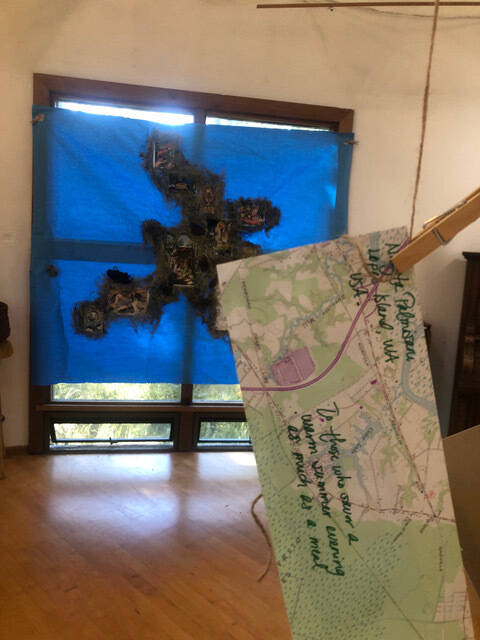Increasing concerns surrounding climate change, food chain supply shortages and other struggles have made locally grown food a hot topic.
“How do we create a robust food system, especially on an island where if the ferry stops running we only have so much food for so long because so much of our food is now imported,” Lopez artist Nikyta Palmisani told the crowd July 15, during her presentation at Alchemy Arts Center.
To better understand the complexities of locally grown food systems, Lopez artists Palmisani, Juniper Blomberg, Oxford researcher Anya Gleizer and Trinity College Dublin Ireland researcher Pablo Fernández Velasco joined together to look at the boundaries one encounters while attempting to eat locally. The group shared their work and experiences with the public July 15.
“There is a serendipitous aspect to the project,” Fernandez told the Journal. ”Anya and I tested positive for Covid right after arriving at Lopez… We spent much of our stay isolated.” As a result, the two were only able to explore Lopez through Palmisani and Blomberg’s storytelling, photos and artistic reactions, and the local food they ate.
“Anya created a series of paintings of the places hinted at in these communications, which resulted in a psychogeographic map of Lopez with moss connecting the nodes and forming our own imaginary Lopez. ” Fernandez said. “In a way, the isolation made it possible to create this map that emerged directly out of the effort of eating local food.”
Palmisani works in a variety of art mediums, but for this project she said, she gravitated toward poetry.
“I have loved mixing the media of actually local foods into tangible letters wherein viewers can have an embodied experience in multiple senses as they read the prose and poetry,’ Palmisani said. “Many of my letters have smells, textures and even local soil embedded within them or inside the envelopes made of maps. So there is a tangibility that viewers can participate in.”
She continued that local foods are extremely tangible and sense oriented, and it requires person-to-person contact, a relationship, with growers. The loss of tangibility through agribusiness and industrialized farming has made people incredibly vulnerable.
“We are no longer in connection with the nonhuman world, the breathing ecosystems around us,” Palmisani said.
The Lopez Land Trust conducted a local eating challenge approximately five years ago. As part of the project, these artists took up the challenge once again, with a slight adjustment. They gave themselves leeway and allowed themselves to partake in a small amount of food, ten to 20 percent, grown outside the region.
“We were a huge bread basket, apples, fish were exported,” Palmisani said. “To the Coast Salish, who should always be acknowledged, this was a robust area of food, a land of great opulence and abundance.”
The shift toward westernized food made the county dependent on industrial food systems, Palimsoni continued. “If that gets cut off, so do we. So how do we really think about climate emergency, all different kinds of potential weather events, all different kinds of disruptions of larger systems which all came into play during COVID,” she said. “Suddenly there was this awareness, what happens when supply chains are broken.”
Lopez, Gleizer told participants, has been working to address the issue and build resilience for decades.
“This kind of living has to be built from the bottom up. What I mean is that it is not going to come from above, from policymakers. It is going to come from those who are studying the local food systems and learning how to address those questions. The local knowledge is no longer there,” Gleizer said, adding it was clear during the pandemic, people were not aware where their food even came from, and what to use if toilet paper ran out. On Lopez, and throughout the county, however, there are systems in place.
“I had never heard of a place so geared toward this,” Gleizer said. All of the artists gave a shout-out to those who worked diligently to create those infrastructures, saying they were standing on the shoulders of giants.
The artists still faced challenges eating locally. The group needed to get creative to eat diverse foods every day.
Because Blomberg comes from a family of farmers, she told the audience that she thought eating locally would be fairly easy.
“I found out it was a lot more challenging. I wanted to do the project and was super excited about it, but I also really wanted to eat chocolate, right now,” Blomberg laughed. “So I ended up breaking the rules more than I thought.”
Blomberg still encouraged others to try the challenge.
“I feel like we have this window of time where we can either switch and push our comfort level, but support our community-based systems, or we can keep going and be in trouble in a little while,” she said.
When asked about the metrics of sustainability, and how to gauge how sustainable a thing is, Blomberg, replied, “I was raised with the value of leaving a place better than when you found it… I measure sustainability by the impact that I have.”
She gave the example of buying flowers for someone, that perhaps was not sustainable, however, the joy the flowers brought the recipient perhaps was worth more by the continuation of joy those flowers spread.
“It is important not to be so linear. We try to codify things so much under patriarchy and Christianity. So maybe I ate a hotdog today that came from the other side of the world. But maybe it gave me the energy to be more generous with my neighbors,” Blomberg said.
To listen to the recording of the presentation visit https://nikytapalmisani.wordpress.com. Check for a slideshow of the event in the coming days.



